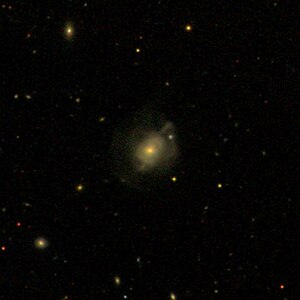IC 646
| Galaxy IC 646 |
|
|---|---|

|
|
| SDSS recording | |
| AladinLite | |
| Constellation | Big Bear |
|
Position equinox : J2000.0 , epoch : J2000.0 |
|
| Right ascension | 10 h 51 m 35.2 s |
| declination | + 55 ° 27 ′ 57 ″ |
| Appearance | |
| Morphological type | SA (rs?) 0 ^ + / Seyfert 2 |
| Brightness (visual) | 14.6 mag |
| Brightness (B-band) | 15.5 mag |
| Angular expansion | 0.9 ′ × 0.4 ′ |
| Position angle | 114 ° |
| Surface brightness | 13.3 mag / arcmin² |
| Physical data | |
| Redshift | 0.046626 ± 0.000166 |
| Radial velocity | 13,978 ± 50 km / s |
|
Stroke distance v rad / H 0 |
(628 ± 44) · 10 6 ly (192.4 ± 13.5) Mpc |
| history | |
| discovery | Lewis Swift |
| Discovery date | May 8, 1890 |
| Catalog names | |
| IC 646 • PGC 32568 • CGCG 267-019 • MCG + 09-18-039 • 2MASX J10513522 + 5527568 • NSA 34521 | |
IC 646 is a spiral galaxy with an active nucleus of the Hubble type Sa in the constellation Great Bear in the northern sky . It is an estimated 628 million light years from the Milky Way and about 165,000 light years in diameter .
The galaxy NGC 3398 is located in the same area of the sky .
The object was discovered by Lewis Swift on May 8, 1890 .
